Lindsey Davis is an English historical novelist, best known as the author of the Falco series of historical crime stories set in ancient Rome and its empire. She is a recipient of the Cartier Diamond Dagger award.
Roger Gilbert Lancelyn Green was a British biographer and children's writer. He was an Oxford academic who formed part of the Inklings literary discussion group along with C. S. Lewis and J. R. R. Tolkien. He had a positive influence on his friend, C.S. Lewis, by encouraging him to publish The Lion, the Witch and the Wardrobe.

Patricia Holm is the name of a fictional character who appeared in the novels and short stories of Leslie Charteris between 1928 and 1948. She was the on-again, off-again girlfriend and partner of Simon Templar, alias "The Saint", and shared a number of his adventures. In addition, by the mid-1930s, Holm and Templar shared the same flat in London, although they were unmarried. Although such co-habitation between unmarried partners is commonplace today, it was rare, shocking in the 1930s. The two also appeared to have a somewhat "open" relationship, with Holm accepting Templar's occasional dalliances with other women.

The House of the Arrow is a 1924 mystery novel by the English novelist A. E. W. Mason, the third full-length novel featuring his recurring character Inspector Hanaud. It has inspired several films of the same title.
Michael Arthur Lewis was a British naval historian, as well as a fiction writer, who was Professor of History and English at the Royal Naval College, Greenwich, between 1934 and 1955.

At the Villa Rose is a 1910 detective novel by the British writer A. E. W. Mason, the first to feature his character Inspector Hanaud. The story became Mason's most successful novel of his lifetime. It was adapted by him as a stage play in 1920, and was used as the basis for four film adaptions between 1920 and 1940.
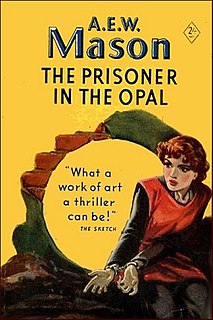
The Prisoner in the Opal is a British detective novel by A.E.W. Mason, serialised in The Pall Mall Magazine and published in book form in 1928. It is the third full-length novel in Mason's Inspector Hanaud series, and the only one to feature the occult as a significant plot point.
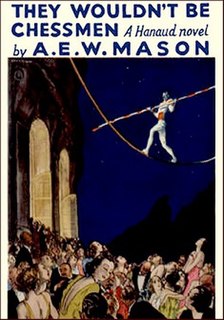
They Wouldn't Be Chessmen is a 1935 British detective novel by A.E.W. Mason. It is the fourth full-length novel in Mason's Inspector Hanaud series.

The House in Lordship Lane is a 1946 British detective novel by A.E.W. Mason. It is the fifth and final full-length novel in Mason's Inspector Hanaud series, published when the author was eighty-one. Unlike the others in the series the story is largely set in England, the Lordship Lane of the title being a thoroughfare in East Dulwich, South London.
Inspector Gabriel Hanaud is a fictional French detective depicted in a series of five novels and one novella by the British writer A. E. W. Mason. He has been described as the "first major fiction police detective of the Twentieth Century".
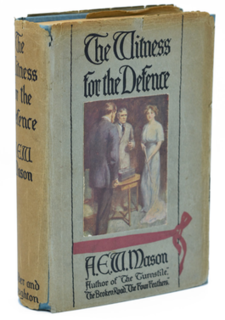
The Witness for the Defence is a 1913 mystery and adventure novel by the English novelist A. E. W. Mason, published by Hodder & Stoughton. Considered one of Mason's best, it was adapted by the author from his 1911 stage play of the same name. In 1919 it was made into an American silent film The Witness for the Defense directed by George Fitzmaurice.

Miranda of the Balcony is a novel by the British writer A.E.W. Mason, first published 6 October 1899. It has been called a modern re-telling of Homer's Odyssey and was one of the sources used by James Joyce for his 1922 novel Ulysses.

The Turnstile is a 1912 political novel by the English author A. E. W. Mason. The novel's fictional hero was based party upon the author's own experiences as a Member of parliament, and partly upon his friend Robert Falcon Scott, who at that time had yet to start out on his ill-fated expedition to the South Pole.

Concordia Merrel was a British stage and silent film actress, photographer's model and a prolific author of romantic fiction.

The Affair at the Semiramis Hotel is a 1917 detective novella by the British writer A. E. W. Mason featuring his character Inspector Hanaud. Mason had originally written many of the plot elements for an abortive silent film, to be called The Carnival Ball. The novella appeared between Mason's first full-length Hanaud novel, At the Villa Rose (1910), and his second, The House of the Arrow (1934).

The Summons is a 1920 novel of adventure and romance by A. E. W. Mason, published by Hodder & Stoughton. Set just before and during the Great War, the novel recounts the adventures of Martin Hillyard, a secret service agent, and his army officer friend Harry Luttrell who aims to restore the battered reputation of his regiment.
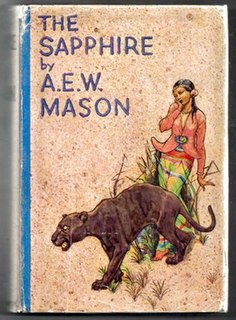
The Sapphire is a 1933 novel of mystery and adventure by A. E. W. Mason, published by Hodder & Stoughton.
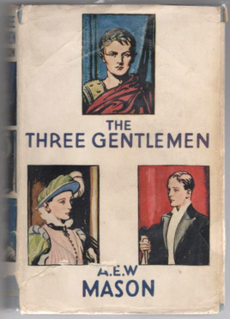
The Three Gentlemen is a 1932 novel of adventure and romance by A. E. W. Mason, published by Hodder & Stoughton. It follows the story of a young couple in ancient Roman times whose love spans the centuries as they are reincarnated in the Elizabethan era, and finally in the early 20th century.
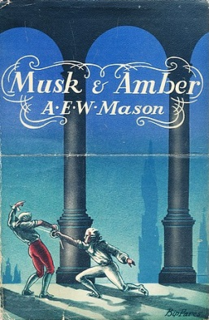
Musk and Amber is a 1942 adventure novel by A. E. W. Mason, set in Eighteenth-century England and Italy. It was his penultimate work, written at the age of 76, and has been considered his very best.
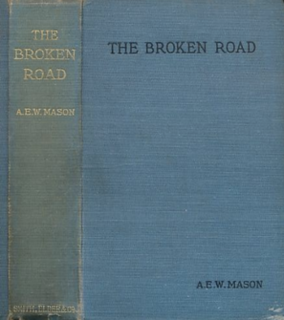
The Broken Road is a 1907 novel of adventure and romance by A. E. W. Mason, set in India during the period of British rule. It first appeared in serial form in The Cornhill Magazine. As a result of the book's publication, the British Government abolished a regulation that had prevented soldiers of the British Indian Army, no matter how valorous, from being eligible to receive the Victoria Cross.
















